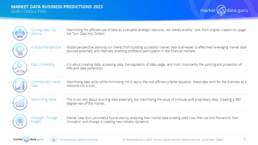
WHAT ARE WE LOOKING OUT FOR IN 2023?
The funny thing about Columbus discovering America is he was actually, really, really, late to the party, and the locals had already started before he arrived. In market data, the exchanges, data sources, and vendors are about to discover something similar, these new markets they are about to rock up to already have inhabitants. Hopefully once the putative market data ‘Santa Maria’s’ drop anchor and survey the riches of their new markets they adopt a less exploitative approach than a Cortez or Pizarro.
The point is there are new worlds beyond the old world of financial institutions. The old world may be richer, but like in history the new worlds could well surpass it.
Again, as in history the maps taking us in the direction of new markets are incomplete, and they lie towards different points on the market data compass. The questions now faced is ‘in which direction shall we go?’
Here are our 5 thoughts on New Markets waiting to be discovered:
1.Third Party Data Processing & Facilitation
2.Digital Media & The Retail Market
3.Wealth Management & High Net Worth Individuals (HNWI)
4.Creating more Compelling Data Malls
5.Better Compliance & Reporting
WE ANALYSE IN MORE DETAILS
1.Third Party Data Processing & Facilitation. In both Pre-Trade and Post-Trade many functions can be done in bulk by more efficient external organisations supporting multiple institutions. This includes algo trading, smart order routing, post trade data inputs & outputs, potentially any area of data processing supporting investment decisions, and particularly reporting.
This introduces a completely new hybrid data consumer segment, part vendor, part user which currently sits outside existing data workflows. While attractive to buy-sides and smaller sell-side institutions, the presence of these hybrids will increase the need for data because they have to support trading activity in a wider range of markets.
2.Digital Media & The Retail Market. The internet and media behemoths of Google, Microsoft, Verizon, and their fellow travellers distribute a vast array of financial data, which costs them next to nothing, out into the marketplace which draws an increasing audience into using the services from which they benefit immensely. Delivery in itself is not enough.
It enables the mass digital market to plug directly into trading creating new flows, initially most visible in the Crypto and FX markets, now extending into equities and listed instruments as well. Companies like TradingView and BarChart offering analytical tools with historic data are tying up with brokers to offer new channels to trade based on optimised analytics with functionality. The trend towards greater choice in trading connectivity and data required in digital media and the retail market is going to strengthen and bypass legacy thinking.
3.Wealth Management & High Net Worth Individuals (HNWI). Traditionally this has been a low cost sector, free delayed data proving perfectly adequate for advisory and portfolio management, but this is changing thanks to Wealthtech, and the fervour Private Equity has embraced by investing in Wealthtech solutions. More clients want real time data, the wealth managers increasingly use more models and analytics to provide value added services.
Cost will be a priority, which opens the door to more competitive smaller data providers, but the need to offer high levels of service will drive data consumption in 2023. At the same time the HNWI segment is becoming more active made up of investors who want greater direct line of sight on their investments but still want to use the services of wealth managers, especially across the Asia-Pacific region and to a lesser extent the US, UK, and Middle East
4.Creating more Relevant Data Malls. Data Malls have been around for a while, varying from the more sophisticated like Quandl and IEX to the very basic price history based offerings of exchanges. Little thought has gone into how they can be leveraged to create mini-clouds which focus on and can add value to the data sources, exchanges, and vendors core products. If we time travel back 30 years to London’s Oxford Street, stores like Selfridges were traditional in concept based around products, now they are Malls where the focus is brand.
Data Malls offers both vendors and exchanges the ability to combine third party services, like analytics with their own data universes, thereby opening up access to a new consumer base. This is a longer term partnership play which helps deepen local relationships in particular.
5.Better Compliance & Reporting. It may seem strange to place better compliance and reporting in discovering new markets, but when one considers that MDG’s figures for market data revenue leakage from exchanges benchmarks at 22+% and certain vendors believe it exceeds 40%, then it is obvious this is a new market. More effective reporting, analysis, and understanding of the clients ought to be one of the major strategies for 2023, because:
- It ensures a level playing field between the compliant and non-compliant data consumers. Regulatory friendly.
- It reduces the need to rely upon raising frees to increase revenues. Regulatory friendly, and avoids penalising compliant clients for a second time
- Fastest and most cost effective way to increase revenues by fairly applying the rules
SUMMARY
Exchanges and Data Sources face a problem the vendors do not have in exploring new markets, their businesses are structured to manage a very limited set of clients, primarily their key vendors, inevitably Bloomberg and Refinitiv, plus a core set of usually about 10 domestic and global banks. This is an artificial limitation, but one requiring management to develop a broader market perspective than they currently possess.
The incentive is to grow and build revenues from existing data services by growing beyond the existing client base.
Opportunities in 2023
- Eliminate unnecessary high revenue leakage. Strategies to understand who the data consumers are, with analysis and reporting is a new market that introduces fairness and produces revenues
- Levelling Up. Creating new revenues from data that had previously been undervalued, i.e. historic and how this data is leveraged in the market
- Broadening the Client Base. Expanding the universe of clients while reducing reliance upon an existing data saturated consumer base, taking advantage of technology able to deliver applications with greater functionality, therefore requiring more data
- Flexible Data Suites. Building products and services tailored to the digital media and mass market consumer
- New Revenue Flows. Generating new revenues from new clients by leveraging the understanding of data workflows
- Flexible Business Models. Inspiring innovation in business and pricing models that can be used to enter more new markets, which we discuss in more detail in our last article
New markets require new approaches and this will be the biggest challenge of all in 2023.
Keiren Harris 07 February 2023
Please contact info@marketdata.guru for a pdf copy of the article
For information on our consulting services please email knharris@datacompliancellc.com


